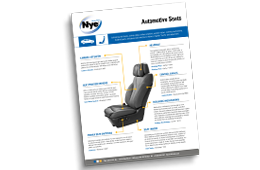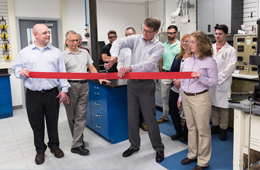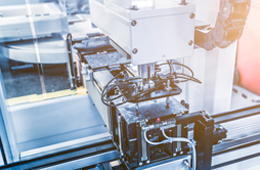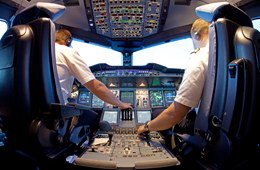Nye LubeLetter - June 2017

Lubricating Automotive Seat Components
 Both passengers and drivers want a “quality” feel when adjusting automotive seats to their desired comfort levels. Seat recliner mechanisms must be able to move forward and backward with a smooth, controlled motion. The control cables that actuate these seat movements can be under high loads and constant cycling. As well, the seat track assembly must allow for positional movement without rattling or vibrating at high speeds. Lubricating these components will improve efficiency by reducing friction, allowing the components to move under a broad range of operating conditions in a quick, smooth manner. Download the Automotive Seat Application Overview to learn which lubricants are recommended for seat tracks, control cables, lumbar actuators, position motors, reclining mechanisms, headrest posts, and power seat switches.
Both passengers and drivers want a “quality” feel when adjusting automotive seats to their desired comfort levels. Seat recliner mechanisms must be able to move forward and backward with a smooth, controlled motion. The control cables that actuate these seat movements can be under high loads and constant cycling. As well, the seat track assembly must allow for positional movement without rattling or vibrating at high speeds. Lubricating these components will improve efficiency by reducing friction, allowing the components to move under a broad range of operating conditions in a quick, smooth manner. Download the Automotive Seat Application Overview to learn which lubricants are recommended for seat tracks, control cables, lumbar actuators, position motors, reclining mechanisms, headrest posts, and power seat switches.

Grand Opening of the Applied Science and Tribology Lab
 The Applied Science and Tribology Lab (ASTL) at Nye Lubricants was developed to bridge the expertise in our R&D group, where new lubricants are formulated, and the Application Development and Validation Testing (ADVT) lab, where application simulation and pre-validation test development is the focus. The ASTL group will be focused on simulating application contact mechanics to better understand the critical relationships between materials, contact geometries, and tribological film formation.
The Applied Science and Tribology Lab (ASTL) at Nye Lubricants was developed to bridge the expertise in our R&D group, where new lubricants are formulated, and the Application Development and Validation Testing (ADVT) lab, where application simulation and pre-validation test development is the focus. The ASTL group will be focused on simulating application contact mechanics to better understand the critical relationships between materials, contact geometries, and tribological film formation.
![]()

Lubricants in Flight
Nye Aviation lubricants are designed to improve the functionality, reliability and longevity of aircraft components. Proper function of airframe components during takeoff and landing is absolutely critical to successful aircraft operation. Primary flight controls need to activate properly as desired by the pilot when the aircraft is in flight. The electronics and avionics systems found in an airplane cockpit rely on lubrication to ensure that these crucial flight systems perform properly. Interior components found in the cabin also rely on lubrication to ensure quality sound and feel of operation for passengers. Download our new Aviation Solutions brochure to learn more about the lubrication needs of airframe, avionics, engine, and cabin components
![]()

Case Study: Semiconductor Equipment Manufacturer
 A company that manufactures semiconductor processing equipment approached Nye about lubricating the rail in a linear guide system. The company wanted to reduce wear in the sliding application. The environmental conditions were high vacuum, and typical operating temperatures ranged between 25°C and 150°C. To prevent contamination and premature failure of the system, the company required a lubricant with low outgassing, excellent friction/wear properties, and low particle generation. Learn how Nye was able to meet all parameters of the customer specification and reduce frictional torque on the sliding surfaces.
A company that manufactures semiconductor processing equipment approached Nye about lubricating the rail in a linear guide system. The company wanted to reduce wear in the sliding application. The environmental conditions were high vacuum, and typical operating temperatures ranged between 25°C and 150°C. To prevent contamination and premature failure of the system, the company required a lubricant with low outgassing, excellent friction/wear properties, and low particle generation. Learn how Nye was able to meet all parameters of the customer specification and reduce frictional torque on the sliding surfaces.



